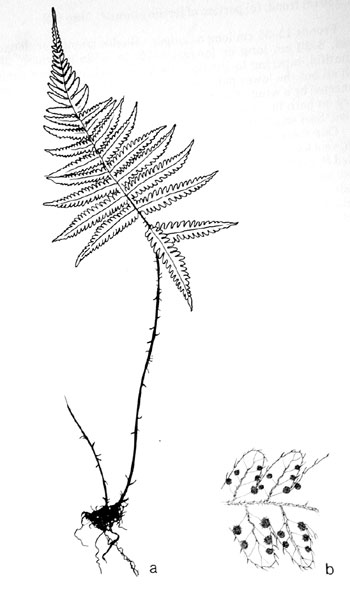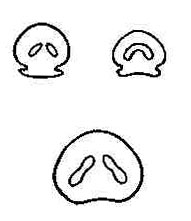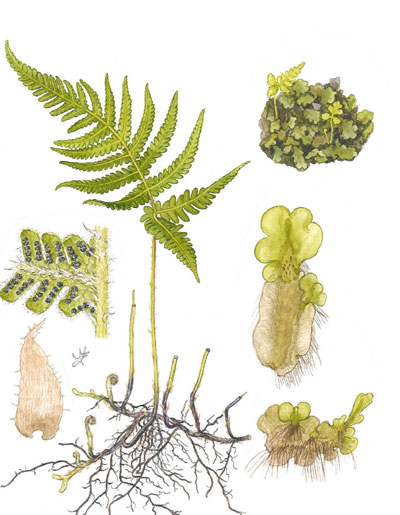| Phegopteris connectilis | ||
Northern beech fern, narrow beech fern | ||
|
Etymology
Connectilis is from the Latin, conecto, to fasten together. See the description of the pinnae.
Description
Rhizome: long-creeping, branching, black, ovate scales.
Frond: 50 cm high by 15 cm wide, deciduous, new fronds all summer, monomorphic, blade/stipe ratio: 1:1 or less. Stipe: straw-colored at base, scales tan, lanceolate, below, and pointed hairs on both sides, vascular bundles: 2, elongate, at 90�, merging or not by the top of the stipe. Blade: 1-pinnate-pinnatifid, triangular, broadest at base, usually somewhat longer than broad, light green, transparent needlelike hairs and spreading, ovate-lanceolate scales on rachis below. Pinnae: 12 to 15 pair, base fused to rachis, the lowest pair (or two lowest) unconnected by wings to the upper ones, lowest pair typically drooping down and out; costae not grooved, ovate-lanceolate, light tan to shiny brown scales below; veins free, simple or forked. Sori: round , near the margin, lower pinnae, indusium: absent, sporangia: tan, maturity: early to midsummer. Dimensionality: lowest pinnae bending forward and down. Culture
Habitat: boreal, wet temperate, and cool climates, moist, calcareous cliff crevices .
Distribution: circumboreal.
Hardy to -40�C, USDA Zone 2.
Distinctive Characteristics
drooping pair of lower leaflets, rachis winged above, not on lowest pinnae
Synonyms
Polypodium connectile Michaux Dryopteris phegopteris (Linnaeus) C. Christensen Phegopteris polypodioides F�e Polypodium phegopteris Linnaeus Thelypteris phegopteris (Linnaeus) Slosson Aspidium phegopteris Baumg. Gymnocarpium phegopteris Newm. Lastrea phegopteris (L.) Bory Nephrodium phegopteris (L.) Prantl Phegopteris phegopteris (L.) Keyserl. Polystichum phegopteris (L.) Roth |
|
|

Phegopteris connectilis. Habit, early June. �Ray Edwards, � 2004. |

Phegopteris connectilis. a) frond, wings between upper pinnae, not extending to the lowest pair; b) fertile pinnules, hairy, costa scaly. �Illustration by V. Fulford from Ferns and Fern Allies of Canada, William J. Cody and Donald M. Britton, 1989, � Agriculture Canada, used with permission. |

Phegopteris connectilis. Two elongate vascular bundles at the stipe base, merging or not at stipe apex. �Drawing from Ferns of Northeastern United States, Farida A. Wiley, 1936. |
